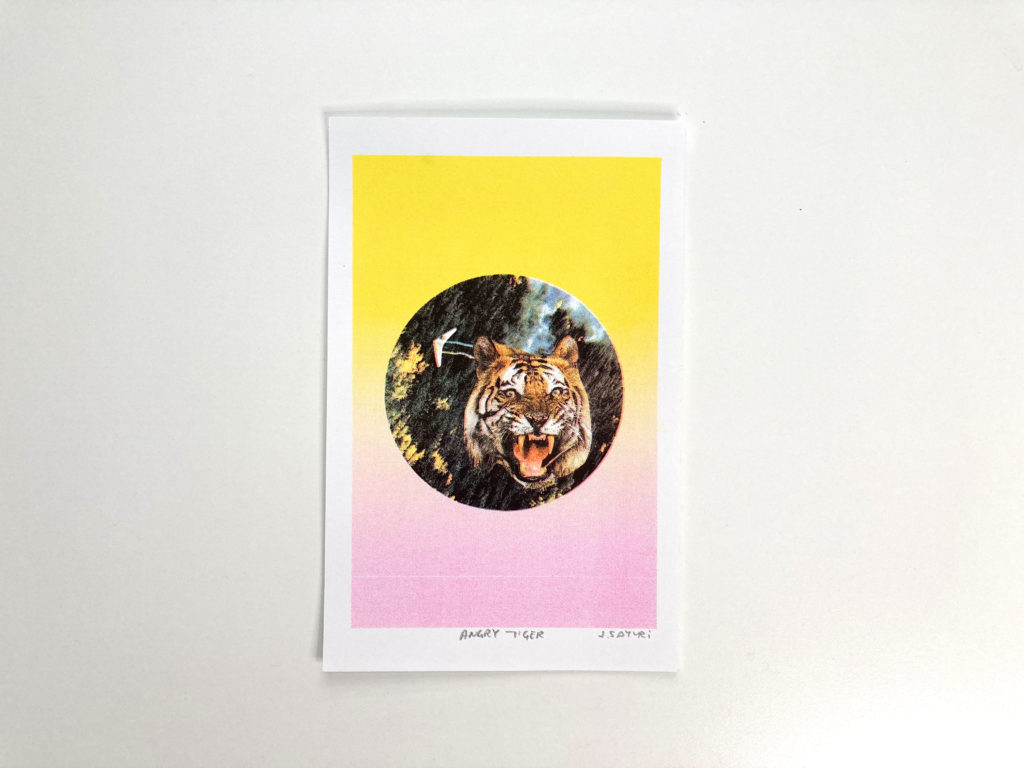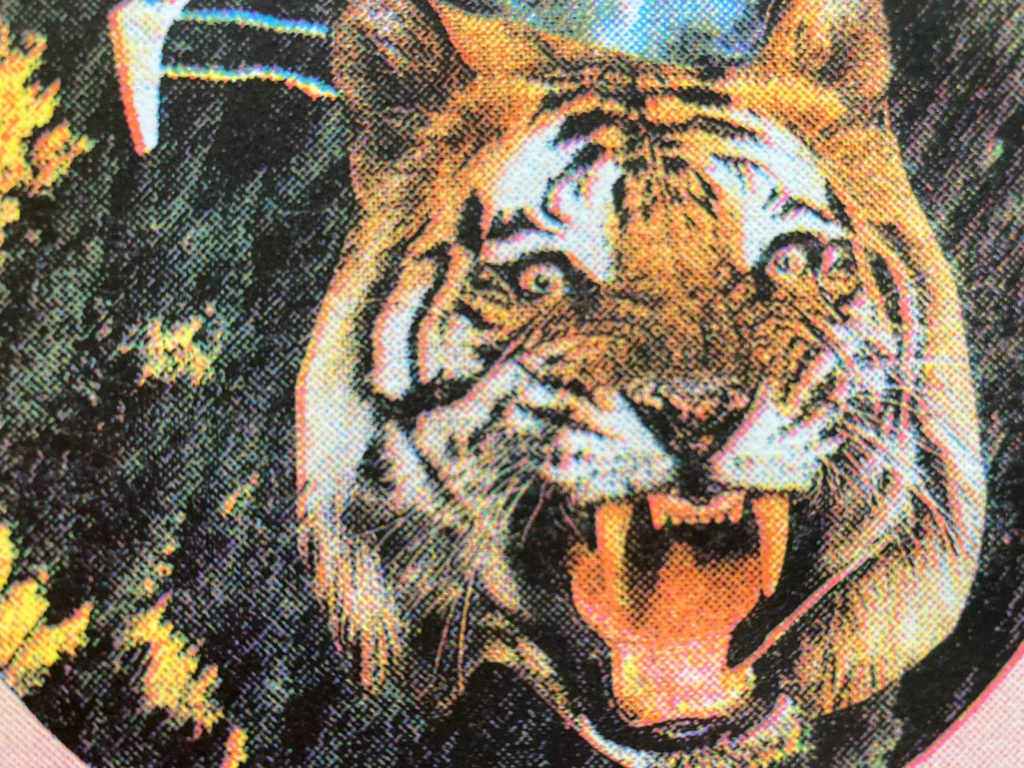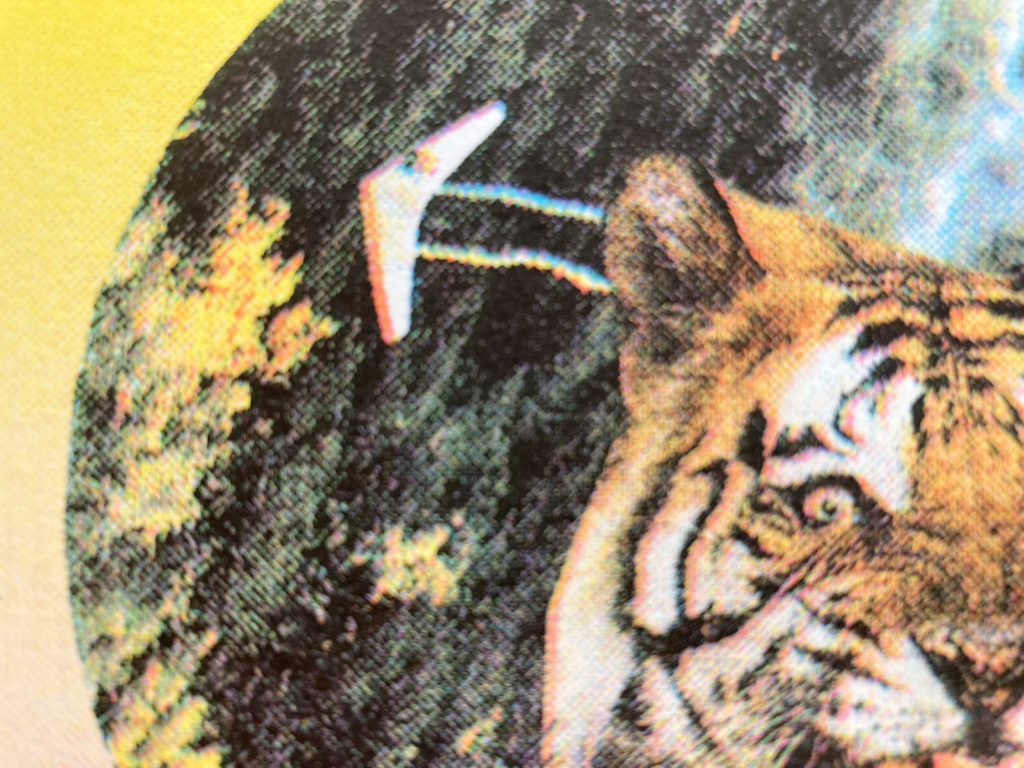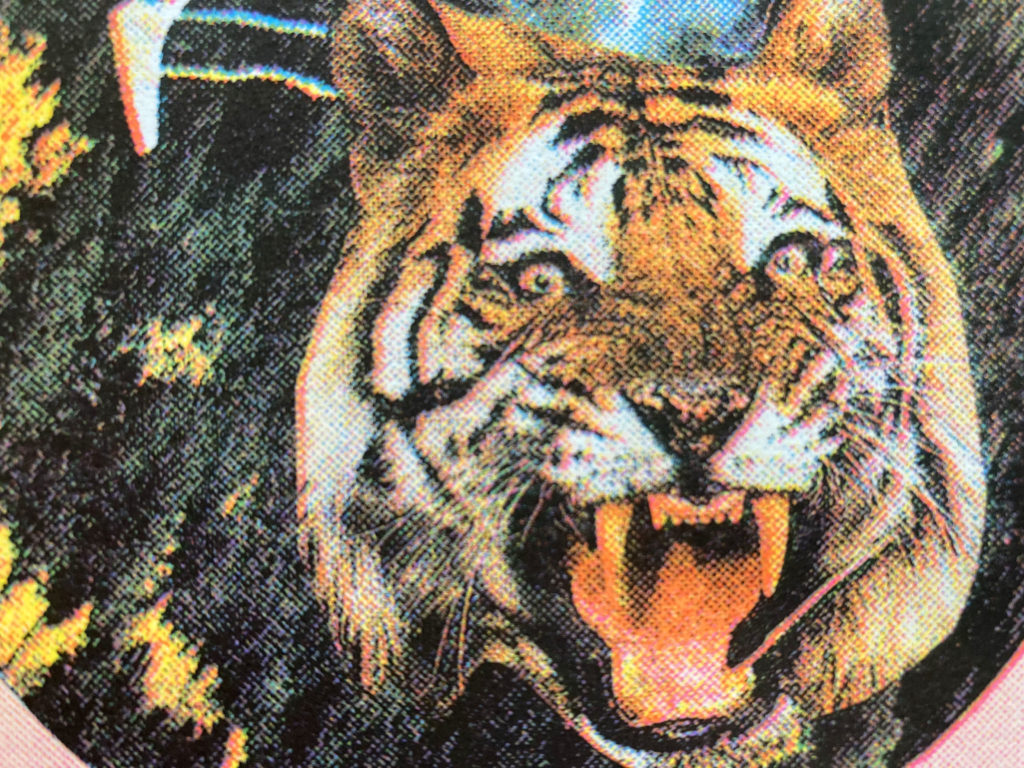I use symbolism in my risograph prints. In the process of piecing together my collages, stories and meaning emerge. In other words, I don’t usually start my collages with a story in mind. Instead, as my collages come together, I recognize pattens and themes that emerge. And I research the images to make sense of the the juxtaposition of specific images.
I am a mixed Japanese-Mexican-Caucasian woman who grew up in Los Angeles. And so, my background influences my work and the symbols I use.

Before I get too deep into my artistic process, you can snag this risograph print for yourself by visiting my Etsy store, TinyPinkShoe. Here is my entire collection of risoprints as well as my pinback buttons and magnets. Thank you for supporting my small business!
Okay, now that I’ve gotten my shop plug out of the way, let’s get into the symbolism in this risoprint. Images of the tiger and manmade vehicles of transportation like trains and planes emerged during this time. At first, this juxtaposition made me think about the relationship between the natural and manmade worlds. However, after researching the the symbolism of the tiger and in ancient China, I learned about the sexist and racist roots of the symbol of the tiger associated with women.
What is Symbolism?
First, let’s establish what symbolism is. Symbolism is an artistic and literary style that uses symbolic images to express ideas and emotions. Symbolism originated in late 19th century France and Belgium, with important figures including Mallarmé, Maeterlinck, Verlaine, Rimbaud, and Redon.
Essentially, symbolism is the idea that things can mean other things.
Culture largely influences symbolism. For example, he language you speak and the literature you read all influence the way you understand symbols.
The symbolism of the tiger is no different. Let’s explore the ways the symbol of tiger differs in Eastern and Western cultures.
Symbolic Meaning of Tigers & Tiger Symbolism
In the West, tigers symbolize strength, power, courage, and ambition. However, in Asia, where tigers originate, the meaning shifts, especially when attributed to women.
Tiger Women
For all its technological and cultural accomplishments, ancient China was sexist and patriarchal. Confucian traditions required women to be gentle and obedient. According to “The Book of Rites,” a collection of texts published in the Han dynasty, unmarried women must obey their fathers, married women were subservient to their husbands. And if their husbands died, women had to obey their sons. Women who failed to follow these requirements were labeled ‘female tigers.’ Female tiger or tiger woman was an offensive term for tough or “unreasonable” women.

Tiger Mom and it’s Racist Roots
The term ‘tiger woman’ later evolved into the racist and sexist, modern day term, ‘tiger mom’. To clarify, the term ‘tiger mom’ is, in fact, insulting, sexist, and racist because it perpetuates the false idea of the model minority – that Asians and Asian Americans have a attained a level of privilege (financially, educationally, and socially) as their White counterparts in the United States.
In essence, this model minority myth underlies the ‘positive’ stereotypes that all Asians are smart, never experience racism, and are equal to White Americans. And, the idea that the ‘tiger mom’ raises a ‘good’ child through pure perseverance and hard work, perpetuates this myth. In fact, this Model Minority Myth is harmful because it erases the breadth of diversity, history of struggle, and current obstacles that face Asian and Asian American communities.
Here is a really great article about why the model minority myth is false by the New Yorker. And here’s video about why this ‘positive’ stereotype is used to reinforce racial stereotypes.
So, upon learning this history, I feel my anger in the anger of this tiger. I feel the weight of this symbol of tiger. The smoke rising from my head, the bared teeth, the bloodlust in the eyes. I feel it all. The plane is almost inconsequential. Almost.
Airplane Symbolism
In this risograph print, the plane is small, but soaring off. It’s as if the tiger missed the flight and is furious. In dream symbolism, airplanes symbolize the following:
- Travel
- Motivaion
- New life direction
- Leaving old life behind

The airplane symbolizes so many transformative and dynamic changes. However because the symbol of the tiger overpowers the plane, it gives the impression of stunted transformation.
Reclaiming the Tiger Symbol
In many ways, Asian women have not moved too far from the patriarchal views of women needing to be obedient and quiet. In fact, in modern day America, Asian women also have to contend with the added layer of racism that dictates how people see them. The notion of the ‘Tiger Mom’ and its counterpart, the Model Minority Myth, trapped Asian women in a world where both their Asian-ness is dismissed but also othered.
The anger of the tiger in my risograph print stems from this frustration with the constant racism and sexism that Asian women face. The rage that they cannot soar in a new direction, that they cannot move past the trappings of the Model Minority Myth. So, the tiger overshadows the plane’s flight. In essence, I communicate that before Asian women can go into a new direction, they must confront this racist and sexist symbol attributed to them. To move forward in the world, financially, socially, and culturally, we have to challenge the ideas of the model minority and the ‘tiger mom.’
In this risograph print, I hope to reclaim the tiger as a symbol of power, ambition, and strength in the face of racism and sexism.
Support Asian Women and Stop Asian Hate
If you enjoyed reading this article, please leave a comment below.
Also, if you are interested in supporting my art practice, get this risograph print for yourself, please go here.
Hate crimes against Asian women are on the rise, so please consider donating to these groups that support the AAPI communities:

